HALIFAX - Dusk lingers, picture-perfect, over Halifax Harbour; a silver moon on the rise, a lighthouse blinking in the distance, skies glowing purple and pink. All along Harbourwalk, a 10-city-block-long path stretching from Casino Nova Scotia in the north to Pier 21 in the south, buskers perform their final shows before dark descends. Fiddle and horn players, accordionists, creators of giant balloons — they all attract holiday crowds.
As for me, the taste of rum lingers on my tongue, the result, I confess, of oversampling the wares at the Rum Runner Rum Cake Factory. This quayside spot on Bishop’s Landing is operated by proud descendants of prohibition-era bootleggers. The cakes (rum or whisky-spiked) were delicious — I’ve bought some to take home — but their provenance is equally seductive.
A few years ago, when the descendants of rumrunner Gordon Stevens found their great-grandmother’s cake recipe, they uncovered her clever scheme to outwit prohibition authorities. So heavily spiked with booze were Bessie Stevens’ cakes that they could only be contraband. But what customs official would suspect an innocent cake?
Modifying the original family recipe, today the Stevens family bake delicious variations on Bessie’s recipe — flavoured either with single malt Glenora whiskey from Cape Breton, or a local favourite, Smuggled Cove Rum. Both the cakes and the story behind them are perfectly suited to a place where good food and good stories count for a lot.
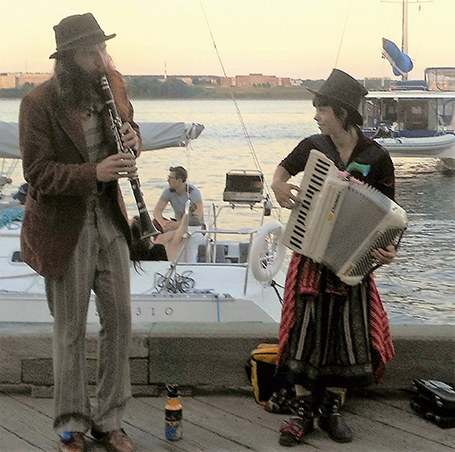
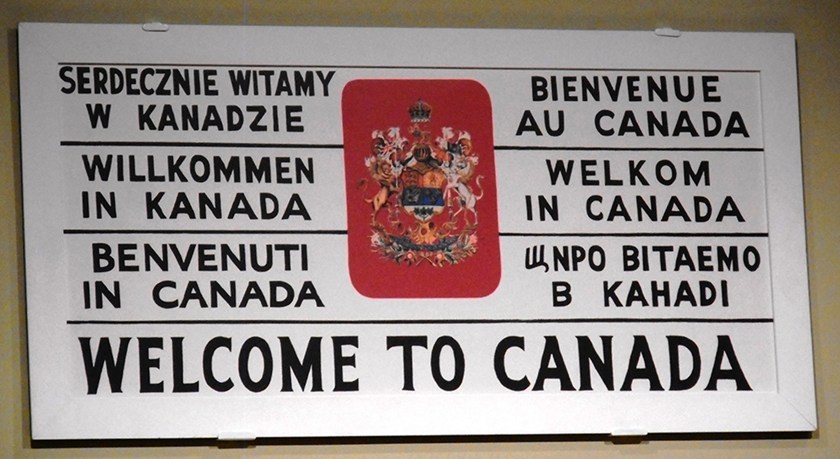
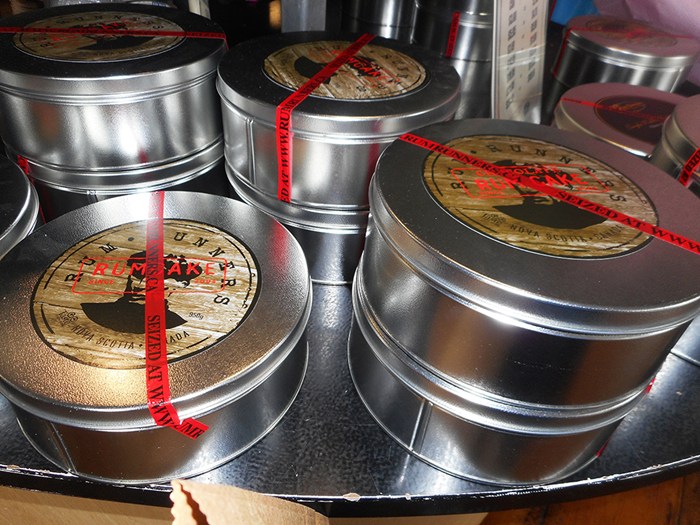
Left: Acrtors remind us of a bygone era when nervous immigrants arrived in a new land. Middle: The Pier 21 Museum reminds us that Canada has always been a welcoming place for new arrivals. Right: Pier 21 Museum has lots of artifacts from years past.
One thing’s as clear as day: for a port city that’s seen more than its share of disasters — a sad number of Titanic burials, a devastating munitions ship explosion in 1917 — Halifax and its waterfront is a contemporary success story.
At the far end of the harbour stands Pier 21, The Immigration Museum, where rum yields to scotch. Until today, I thought “scotch” was a drink — it is of course — but it’s also the word used to describe my maternal ancestors in the 1901 Canada Census — a document printed out by a tech-savvy young woman on the ground floor at Pier 21.
There it is, in black and white, in the box labelled “Race/Tribe.” Neither word sounds right to modern ears, but terminology has evolved in the last hundred-odd years. And if a family labelled themselves “Scotch,” then Scotch they were. Ancestry is only one of the many discoveries that await visitors to Pier 21. Unprepossessing from the outside, this brick building — an Immigration Museum since 2011 — reveals an interior that’s a real knockout and tells it like it is — or was.
A million immigrants started their lives in Canada after disembarking from ships at Pier 21 between 1928 and 1971 and half a million Canadian soldiers, men and women, sailed from here in the opposite direction, bound for European battlefields during World War II.
There are frequent free tours and I tag along with one in progress. A well-informed guide shares nuggets of information about this “very busy” entry point into Canada. Arrivals reached a peak during and after the war, among them “war brides, evacuee children, refugees and displaced persons.” As our guide takes us down memory lane, I remember a friend, born in a displaced persons camp in Germany, telling me that her family — who had fled the Nazi invasion of Latvia — found safe harbour here when she was a child.
People didn’t stay long at Pier 21, they’d undergone medical checks before departing. They received cursory checks from doctors in Halifax and were soon sent on their way. There were exceptions, of course, like the two brothers from Yugoslavia whose parents were suspected Communists. The boys were detained for three weeks, watching thousands of others depart.
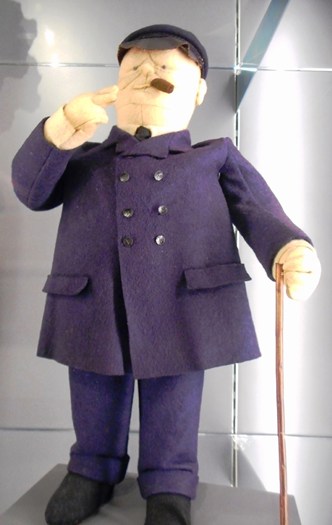
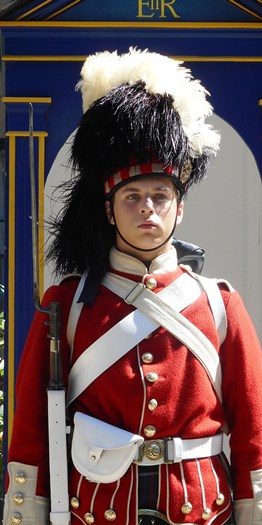
Left: The museum is filled with lots of memorablilia like this Winston Churchill doll left behind by a British arrival. Right: Halifax and its Scottish roots are well guarded at Pier 21.
Trains waited to take newcomers across the country, some heading to relatives or sponsors in various provinces; others arrived in the new land without friends or family. A train coach from a “Colonist Car” — a cross-country ticket back then cost all of $7 — welcomes us aboard. How sparse and plain its benches seem today and how prescient the sign cautioning women travelling alone about befriending strangers.
Most arrivals owned few worldly goods, treasuring the little they had. Many were shocked to have their favourite foods (prosciutto, salami) confiscated and to be treated to boxes of corn flakes instead — a food Europeans associated with animal feed. Decades later, now settled in every province in Canada, many immigrants donated their souvenirs to the new museum. One display case features a photograph of a little girl from England, clutching her Winston Churchill doll. The doll itself is displayed in the adjoining case.
The Dutch were famous for bringing their possessions in large wooden crates called kists. The joke was they brought everything but the kitchen sink, until the day officials discovered an actual kitchen sink in a Dutch kist. In contrast, the 100,000 refugees who arrived after the war often wore everything they owned on their backs. For everyone — from 1920s British Home Children, to the late 1960s dissidents who fled Czechoslovakia when the Soviets invaded their land after the Prague Spring — Pier 21 opened a door into a vast new land.
A multilingual sign reads “Welcome to Canada,” but museum curators have been strikingly honest about the bigotry various groups encountered before joining our cultural mosaic. For many arrivals, the new country represented something entirely unknown. “Will the moon come to Canada with us?” asked one immigrant child quoted in the permanent gallery.
In addition to a fine film that shows the faces of modern Canada, dozens of stories about what brought people here and what happened to them after they arrived line the museum’s walls, accompanied by interactive displays. Historical photographs often prove as dazzling as the stories that former migrants have generously shared with the public.
Leaving Pier 21, I explore the Halifax Seaport Farmers’ Market next door. A woman is playing the harp as I wander among hundreds of stands offering delicious edibles. After purchasing some Lunenburg-roasted Laughing Whale coffee (“the lowest carbon footprint per cup in the Maritimes”), I ascend to the second floor to find works by local craftsmen and designers. My favourite discovery? A dazzling selection of earrings made from butterflies’ wings. Designed by nature herself, they’re enchanting.
The things I’ve expected to discover during my stroll along Halifax harbour — fish restaurants, Irish-themed bars, and a few blocks away, the excellent Art Gallery of Nova Scotia with its permanent exhibit of Maud Lewis’ folk art, a show that even includes Lewis’ fairytale like house — have opened doors onto the city’s treasures and traditions. I’d like to answer that immigrant child’s question and say yes, the moon came with you on your voyage. See? It’s shining right there, over Halifax Harbour.